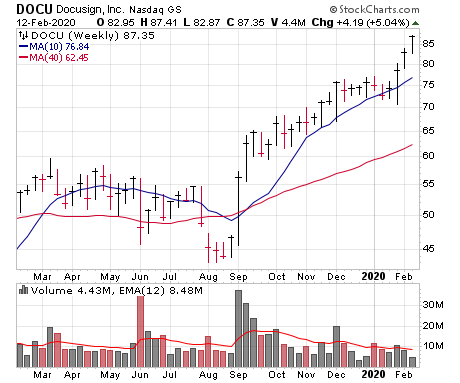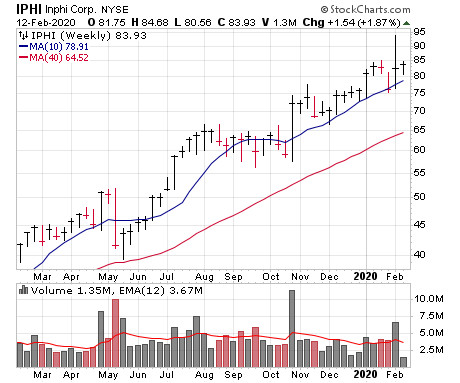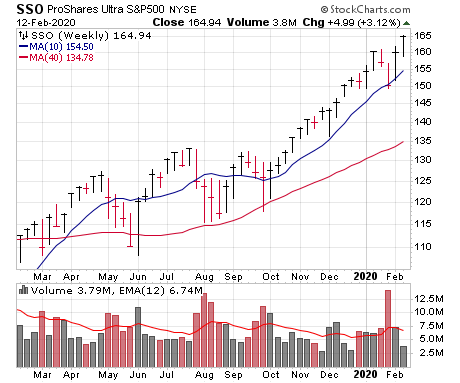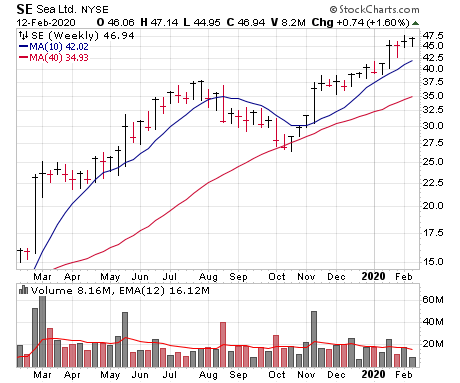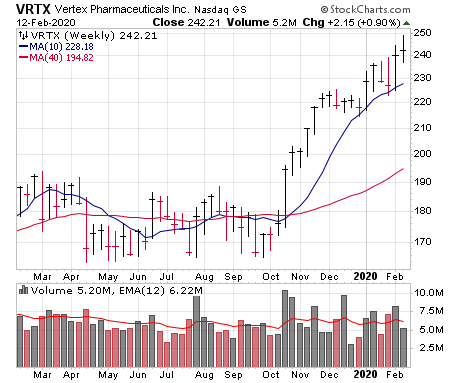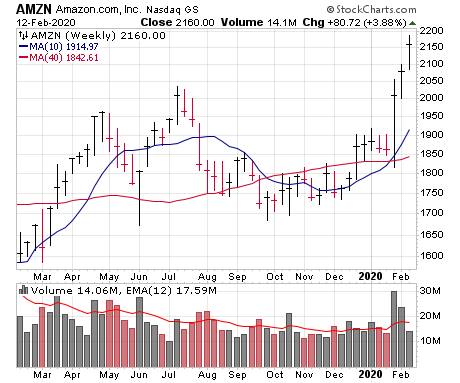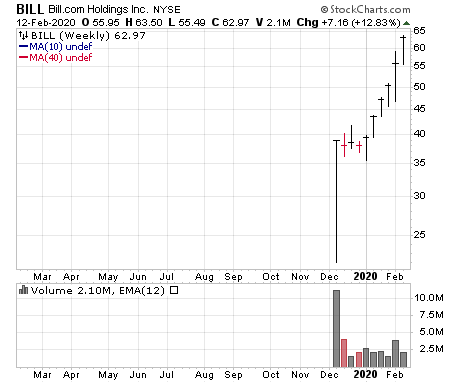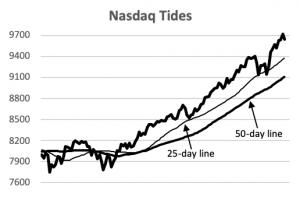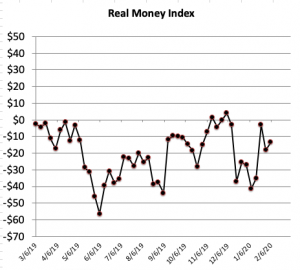The overall market remains in an uptrend, as do most leading stocks, and that’s why we remain mostly bullish. But while we’re positive, we’re not pounding the table, partly because of some secondary measures (most broader indexes haven’t hit new highs in a month) but mostly because individual stocks aren’t offering up many great entry points. Tonight, then, we’re again standing pat, happy to ride our winners but monitoring earnings season closely, both for stocks we own and for those we want to buy.
In tonight’s issue, we go over a few new ideas, including a couple of IPOs from last year that were nailed but are now coming back from the dead; they could be morphing into leaders. And as usual we go over all of our current holdings and our updated watch list.
Cabot Growth Investor 1439
[premium_html_toc post_id="197806"]
Positive—but not Pounding the Table
Every morning when I open my laptop (yes, I do all of my work and research on a MacBook Pro—keep it simple!), I like to flip through a handful of charts of the major indexes and some key stocks to get a quick refresher on the market’s primary evidence. And, as has been the case for four and a half months, it’s hard to find much here that isn’t bullish: The intermediate- and longer-term trend of the market and most leading stocks are in good shape.
Add in the facts that growth stocks remain in favor (our Aggression Index, written about in the last issue, remains solidly positive) and that the market has done well despite plenty of bad news on the coronavirus front, and that’s why we’ve been mostly bullish during this bull run and remain so today.
However, just because we’re bullish doesn’t mean you should be buying hand over fist, as there are a number of signs that the environment is getting trickier. One obvious one: While the S&P and Nasdaq have rebounded to new highs, broader market indexes are still shy of their mid-January peaks. Not surprisingly, the number of stocks hitting new highs has dried up by more than a third during the recent push higher.
Also, when it comes to individual charts, it’s been hard to find good-looking entry points—most of the big breakouts occurred months ago, and controlled pullbacks toward support have been rare, with many stocks showing lots of up-down-up-down action.
To be clear, those aren’t necessarily red flags for the overall market; not every piece of evidence has to imply a huge rally or a major plunge in stocks. And there’s nothing that says that some of the stocks we’ve been waiting on (usually to report earnings) won’t kick into gear and have us hopping onboard. But, when it comes to new buying, these factors have had us mostly sitting on our hands in recent weeks as we ride our current holdings.
From here, while there remain plenty of uncertainties out there, our game plan is pretty straightforward: If the sellers finally show up, we’ll take things on a stock-by-stock basis, possibly trimming and adding to our cash. But if, as the odds favor, the market remains in good shape, we’ll stick with our bullish stance and hunt for some fresh leaders to buy.
What to Do Now
Right now, though, we’re remaining patient, holding onto our crop of winners while keeping a close eye on earnings reactions (both in stocks we own, and ones we’d like to own). We have no changes in the Model Portfolio tonight, which holds around 19% in cash.
Model Portfolio Update
One question we’ve gotten lately is, “Why are you holding 19% in cash given the market’s strength?” The answer isn’t as market-centric as many think. It’s true that, as we wrote on page 1, there’s some conflicting evidence out there—while our market timing indicators are positive, most indexes haven’t yet returned to new high ground, telling us the advance has narrowed a bit.
But, really, it’s not a market call—as an intermediate-term advance continues, we take our cues more on a stock-by-stock basis. And as it turns out, all of the stocks that we’re interested in buying have or are reporting earnings this or next week! Of course, if we were heavily defensive, we would have shoehorned our way into some new positions, but instead, most of our positions have been doing just fine.
That said, as those earnings events move into the rearview mirror, we’ll be looking to put some of our sidelined cash to work should opportunities present themselves assuming the market remains in good shape—though we could start with half-sized positions depending on how things look. Tonight, though, we’re again sitting tight.
Current Recommendations
Dexcom (DXCM 252)—Dexcom will report earnings tonight, which, as with most stocks, will have a big impact on the stock’s intermediate-term future. The company already pre-announced Q4 revenues and 2020 sales guidance, but there will be plenty to dig into in terms of earnings, margins, G6 uptake in various sales channels and any update on the G7 launch (limited release scheduled for late 2020). The stock hasn’t been tearing up the joint of late, but it’s been acting just fine, crawling to slightly higher highs as it rides its 25-day line northward. A huge earnings-induced drop down into the 210 area would be a red flag, but until proven otherwise, we think DXCM has the look and feel of one of the top institutional-quality stocks of this bull move, with a great story, rapid growth and plenty of potential going forward. We’ll stay on Buy, but as always, will be in touch if we have any changes post-earnings. BUY.
DocuSign (DOCU 88)—DOCU has been extremely impressive since its shakeout in late January, motoring to decisive new price and relative performance (RP) peaks (not shown on this chart) on solid volume. There’s been nothing new from the company or from analysts, so we’re viewing the strength as confirmation that big investors are slowly and steadily building positions in what they perceive to be a longer-term winner. Earnings aren’t likely to be released until early- to mid-March. We restored our Buy rating last week, though a dip of a couple of points wouldn’t surprise us after the recent run. BUY.
Inphi (IPHI 84)—All three of our stocks that have reported earnings thus far have topped estimates and given solid guidance, but the stocks then suffered short-term wobbles as profit taking set in. IPHI was no exception, as Q4 sales (up 19%) and earnings (up 4%) topped expectations, led by all things cloud-related, where sales were up 43% from a year ago. While absolute growth didn’t wow anyone, that should change going forward—despite a relatively conservative view of demand out of China, Inphi repeatedly stated that they see widespread strength continuing through 2020 and beyond, and analysts responded by hiking estimates in a big way; Wall Street now sees the company’s earnings up 40% this year and another 48% in 2021 (thanks in part to the accretive buyout of eSignal, which closed in early January). Shares were wild the day after the report, but since then, IPHI has been relatively calm, mostly gyrating in the low- to mid-80s. A drop below the rising 50-day line (now near 78) would probably have us going to Hold (and maybe even taking partial profits), but right here, the trend is up and growth looks set to accelerate, both of which keep us bullish. BUY.
ProShares Ultra S&P 500 Fund (SSO 165)—The late, great Marty Zweig used to say that one of the biggest parts of making good money in the market is simply being there during bull phases, and that’s been our thinking with SSO, which we initially bought more than a year ago when we first started to see some rare, bullish blastoff indicators turn green. It’s obviously been a great run since then, and in the intermediate-term, the risks of a pullback or longer consolidation remain relatively high; that’s one reason why (along with what was a huge position) we took partial profits in this leveraged long fund a couple of weeks back. Still, this bull market likely has a ways to run, and while nothing says we can’t make another small move if the environment turns rough, we’re aiming to hold most or all of our position as we ride out the market’s larger, longer-term move. Hold on if you own some, and if you don’t, you could nibble here or (preferably) on dips of two or three points. BUY.
Qorvo (QRVO 109)—QRVO looked like it was a goner earlier this week, with the stock trading below our mental stop in the 104 to 105 area on Monday as chip stocks struggled. But it’s possible that may have been a low point—shares quickly popped a few points after that before backing off on today’s renewed virus fears. There was nothing in the firm’s recent earnings report that was worrisome, but clearly some big investors thought it wise to book profits ahead of any possible coronavirus reverberations. Yet most analysts remain bullish (one just came out with positive words this week) and, while 5G smartphone production might hiccup due to virus-related shutdowns, there’s no doubt an acceleration in growth is coming. Long story short, we still have high hopes for QRVO, but we’ll just follow our plan—we’re happy to hang on above our mental stop, and a strong-volume push into the mid 110s could cause us to restore our Buy rating. At this point, though, the stock still has more to prove. HOLD.
Sea Ltd. (SE 48)—Sea isn’t going to make many headlines, as few people write much about overseas e-commerce and online gaming outfits, and if they do, they usually talk about the huge Chinese outfits. But we think Sea’s story has many growth drivers that should keep buyers interested. Just this week, one analyst hiked his price target and talked about the gaming opportunity in India, where there are expected to be 350 million gamers by 2022, while also talking about the fact he sees big potential for improved monetization in many of Sea’s e-commerce markets; the cut it takes on each sale in some markets is well below the competition, despite its dominant position. As for the stock, we still wouldn’t be shocked to see some selling (the 50-day line is just above 41), but there’s no question the main trend is up. SE just hit a new high today! Earnings will be released on March 3. BUY.
Teladoc (TDOC 112)—TDOC remains very strong, as even an analyst downgrade yesterday failed to dent the stock. Given that shares just broke out from a 15-month range at the start of the year, we remain optimistic that TDOC is still early in its overall advance, especially as 2020 could be shaping up to be the year where virtual care really takes off. Of course, the short-term is anyone’s guess—the 50-day line is down around 91 and earnings will be released on February 26, so some hesitation is certainly possible. Even so, we think there’s a good chance that the firm’s big 2019 (including the on-boarding 15 million users from UnitedHealth alone) and its acquisition of InTouch (making it a one-stop shop for telehealth services both in and out of the hospital) has meaningfully boosted investor perception. We’ll stick with a Buy rating, advising new buyers to try to pick up shares on dips of a few points. BUY.
Vertex Pharmaceuticals (VRTX 240)—VRTX has seen plenty of sloppy action since earnings—shares are still in fine shape, but there’s been lots of up-down-up-down action, which often signifies distribution after a good run. That’s something to keep an eye on, and if the sellers show up for more than a day or two, we could go to a Hold rating. But to this point, we’re not overly worried as the damage has been limited (the stock hit a new high on Tuesday!), and it’s possible the volatility is caused by some investors gaming out political uncertainties in the sector, which would likely prove temporary. (We’re not touching politics with a 100-foot pole; we’re simply reporting on the scuttlebutt that’s out there.) Moreover, the big picture is as bright as ever—analysts see earnings surging both this year (up 44%) and next (up 33%), and the fact that the stock just got going in October after two-plus-years in the doghouse means it should have lots of gas left in the tank for a longer-term upmove. All in all, we’re sticking with our Buy rating, though we’ll be watching the action to see if things settle down a bit. BUY.
Watch List
- Alibaba (BABA 220): BABA reported a fine quarter this morning (sales up 36%, earnings up 47%), though the stock hesitated. While some other Chinese names have been stronger since the virus outbreak, we still favor Alibaba’s overall story, numbers and long-term chart (at all-time highs).
- Datadog (DDOG 49): Datadog is one of two leaders we’re following (along with Dynatrace, below) in the booming application performance management and infrastructure monitoring field. We love the potential, but we’ll see what happens after the firm releases earnings tonight.
- Dynatrace (DT 36): Dynatrace is Datadog’s cousin, with a bit of a narrower focus, but it’s also seeing accelerating growth and is already profitable. A pullback of a point or two would be tempting.
- Uber (UBER 40): Uber is on the comeback trail after a horrible first few months as a public company. See more below.
- Zillow (Z 52): We think housing-related stocks could surprise on the upside, and Zillow combines exposure to that cyclical sector with massive upside thanks to its ramping Offers business. Earnings are due out February 19.
Other Stocks of Interest
Amazon.com (AMZN 2,150)—We’re celebrating our 50th anniversary of publishing this advisory in 2020, and during that time we’ve learned a few things, one of the key ones being: Never underestimate a mega-cap growth stock that gaps out of a huge launching pad on earnings. That’s why we’re writing about Amazon today. Unless you’ve been living under a rock, you know the gist of the story here, as the company is the king of e-commerce: It’s taking an increasing share of the U.S. (and international) retail pie, all while building a giant cloud computing business, operating a leading streaming video service, having one of the most popular connected home devices and much more. And as opposed to a few years back, the company is highly profitable these days (analysts see the firm’s earnings up 24% this year and 41% next). But all those good tidings have been in place for a while—what’s changed is the chart. Like many big-cap growth names (Facebook, Netflix, Square, etc.), AMZN topped a while ago (September 2018) and spent well over a year scaring out and wearing out investors. But that long consolidation came to an end after the firm reported Q4 earnings that easily topped estimates and helped the stock gap up, and as the market has rebounded from the virus-related weakness, AMZN has pushed solidly to new high ground. Of course, being so well known and well followed, the stock is unlikely to be the fastest horse out there, but this pattern—a big consolidation followed by a powerful, earnings-induced breakout—has a great history of leading to higher prices in mega-cap growth stocks. Long story short, we see higher prices ahead.
Bill.com (BILL 62)—One of the bigger growth themes in recent years has been technology firms that help mostly small- and mid-sized businesses (SMBs, for short) do better in the new, digital economy. Bill.com looks like a new leader of this theme with a big, easy-to-understand story: The company’s cloud-based, AI-enabled platform allows these outfits to connect to their suppliers and clients, generate and process invoices, send and get payments and (importantly) sync with their accounting system. (Bill’s offering is actually integrated into many popular accounting software, banks and payment processors.) Despite the internet taking over everything, a whopping 90% of SMBs are still doing all of the above on paper, including many of the six million SMBs that have employees (non-proprietorships), which is Bill.com’s target market. Big picture, the company’s offering saves its customers tons of time and money, so it’s no wonder it’s being adopted rapidly: Revenues have grown in the 50% range each of the past four quarters, while core subscription and transaction revenue lifted 61% in Q4 and other sub-metrics (served 85,900 customers, up 20%; processed $24.8 billion of payments, up 41%) looked great. Moreover, as with all good software players, history shows that clients that sign up end up providing a gusher of business to Bill.com once they’re up and running. (Indeed, management guided to another year of 50%-plus revenue growth in 2020.) It’s a big idea, and this newly-public stock (IPO’d in mid-December) is off to a good start, including last week’s earnings-induced pop. It’s too thin for us at this point (~$30 million of average volume), and a pullback is certainly possible, especially as new issues have a history of being a bit wild. But we don’t think there’s anything wrong with nibbling (preferably on dips), and for our part, we’ll be watching to see if BILL can settle down and “grow up” in the weeks ahead. It looks like a great, long-lasting growth story.
Uber (UBER 40)—It seems like every year there’s one high-profile IPO that comes public to a ton of fanfare and then falls flat on its face. In 2019, Uber took home that prize, getting nearly cut in half in the summer and early fall. Still, while sharp, such an IPO droop isn’t uncommon, and there’s no questioning that Uber is a company that has changed millions of lives, putting it in a category of many big winners. And, while the first couple of quarterly reports after coming public were just so-so, the one released two weeks ago was terrific—gross bookings (the total amount charged customers) were up 30% on a currency-neutral basis, while revenues (money that went to Uber, not drivers) rose 39% (an acceleration from recent quarters), while cash flow from the core Rides segment was solidly positive, growth in the Eats business (food delivery) was excellent (bookings up 73%) and management sees the company as a whole turning EBITDA positive in Q4 of this year. Bigger picture, Uber’s international platform and network of drivers make it the “operating system” for modern city life in hundreds of cities around the world, and there’s plenty of untapped potential overseas and from newer areas (Eats and even Freight); analysts see the top line growing 29% this year and 23% next, both of which are probably conservative. Just as important, the stock has come to life in a persistent way—UBER bottomed in November and has shown excellent strength this year, including last week’s big-volume move on earnings. There’s a bit of old, post-IPO overhead to chew through, but it certainly appears that perception has turned the corner, with big investors focusing on big profits down the road. UBER is on our watch list.
Last Year’s IPOs Coming Back to Life
Despite the healthy gains in the overall market last year, there were a bunch of IPOs that came public and, after a few weeks, went over the falls and were written off as dead. Interestingly, though, we’re now seeing many of these begin to recover, oftentimes in a hurry. In total, these charts don’t fit all of the characteristics we look for (many aren’t yet in true uptrends) but there is precedent for some of these initial IPO duds to produce great advances, though you have to be discerning.
Our favorite scenario with these IPO turnarounds is when a high-profile new issue comes public to great fanfare but then gets clobbered for many months, convincing the crowd that the company really isn’t anything special. Of course, the decline usually has nothing to do with the business, and eventually, big investors step in and drive the stock back up over many weeks (not just one or two good days) and recoup most of the lost ground.
The obvious example here is a stock we wrote up above: Uber (UBER), which has kited higher for 13 weeks (three full months) after getting clobbered last summer and early fall. No, it’s not a perfect setup this second, but it’s likely most weak hands were flushed out and big investors have clearly been stepping in.
If you can’t find a name that has a pronounced uptrend, you at least want all of the other pieces in place—big sales and earnings growth, good liquidity and some recent, overwhelming buying power that tells you the tide has possibly turned.
One that fills the bill is Zoom Video (ZM), a stock we were eyeing last year but thankfully didn’t pull the trigger on, as it eventually fell 43% following its post-IPO advance. But nothing has changed with the company’s story—it has what most believe is the best video conferencing solution available, as unlike competing products, it was built from the ground up to handle video (as opposed to being a voice conferencing solution that was added onto to handle video), leading to improved performance and ease-of-use.
The firm also plays in the cloud-based phone market, too, which is still in the early stages of being adopted. All told, the products have been a hit, with revenues growing at 80%-plus rates, earnings in the black thanks to a surge in big customers (up 97% in Q3) and rapid growth from existing clients (six straight quarters of same-customer growth above 30%!).
As mentioned above, the stock was taken apart for a while before building a bottom from mid-October through year-end. But now the buyers are coming back—last week saw a major volume clue (heaviest week in ZM’s brief history) and it’s now recouped nearly three-quarters of its decline. As with UBER, the setup isn’t perfect (old overhead to chew through), and Zoom still has earnings coming out (due March 4). But we’re keeping an eye on both of these names—if buyers continue to come back to last year’s IPOs, names like UBER and ZM could morph into new, institutional-quality leaders.
Earnings vs. the Market
One of the big misconceptions out there is that the market is tightly linked to the economy, or at the very least, to earnings growth. But as with many things in the market, logic doesn’t always apply in such a direct manner. What really drives stock prices is investor perception of future earnings, and that perception can stay elevated (or depressed) for a very long time.
Look no further than the 2000-2013 period. Back in 2000, the S&P 500 as a whole earned around $54 per share, and 13 years later, that figure was around $87, a gain of more than 60%. Moreover, longer-term interest rates plummeted during that time, from around 6.5% on the 10-year Treasury to 2% or so. Just based on that you’d figure the market would have done pretty well.
But it didn’t, making no net progress during those 13 years! The reason? Investor perception of the future faded, from the “we’ll never have another recession again” mentality of the internet bubble, though the panic of 2008-2009 and into the worries of the early 2010s as many economies struggled to bounce back.
The “divergence” between earnings and the market can occur on a year-by-year basis, too. For instance, one common worry is that 2019’s heady gains in the major indexes came despite basically no earnings growth—according to Barron’s, last year’s bottom line for the S&P rose a mere 0.6%. But, again, such action isn’t unusual even though it seems to be. After all, the opposite happened in 2018—that year, the S&P fell around 6%, yet earnings soared 23%!
Bottom line, if investing were as simple as buying or selling based on earnings projections, we’d all be rich—but that’s not how it works. Instead, you to have track investor perception, which can best be discerned simply by following the action of the market and leading stocks.
Cabot Market Timing Indicators
There are a few secondary pieces of evidence that bear watching, such as some divergences among the major indexes and fewer stocks hitting new highs. But the primary evidence (trends of the indexes, action of leading stocks) continues to be positive, so you should remain mostly bullish.
Cabot Trend Lines: Bullish
Our Cabot Trend Lines remain firmly in the bullish camp, with the S&P 500 (by 8.7%) and the Nasdaq Composite (by 13.2%) ending last week miles above their respective 35-week lines, and climbing higher so far this week. Thus, it’s the same story—short-term, there’s certainly risk of a correction, but there’s no question the longer-term trend is pointed up.
Cabot Tides: Bullish
Our Cabot Tides are also bullish, with all five indexes we track (including the Nasdaq Composite, daily chart shown here) above their lower (50-day) moving averages. The fact that only the big-cap S&P and Nasdaq have hit new highs since the virus selloff in late January is something to watch, but we’ve found trends to be more reliable than divergences, and the Tides tell us the intermediate-term trend remains up.
Cabot Real Money Index: Neutral
Our Real Money Index remain neutral, with not enough money flowing out of (or into) equity funds and ETFs to tell us investors are leaning too heavily in one direction or the other. As has been the case for more than a year, though, money continues to generally get pulled out of the market despite rising prices, which at the very least says that greed isn’t getting out of hand.
Charts courtesy of StockCharts.com
The next Cabot Growth Investor issue will be published on February 27, 2020.
Cabot Wealth Network
Publishing independent investment advice since 1970.
CEO & Chief Investment Strategist: Timothy Lutts
President & Publisher: Ed Coburn
176 North Street, PO Box 2049, Salem, MA 01970 USA
800-326-8826 | support@cabotwealth.com | CabotWealth.com
Copyright © 2020. All rights reserved. Copying or electronic transmission of this information is a violation of copyright law. For the protection of our subscribers, copyright violations will result in immediate termination of all subscriptions without refund. No Conflicts: Cabot Wealth Network exists to serve you, our readers. We derive 100% of our revenue, or close to it, from selling subscriptions to its publications. Neither Cabot Wealth Network nor our employees are compensated in any way by the companies whose stocks we recommend or providers of associated financial services. Disclaimer: Sources of information are believed to be reliable but they are not guaranteed to be complete or error-free. Recommendations, opinions or suggestions are given with the understanding that subscribers acting on information assume all risks involved. Buy/Sell Recommendations: All recommendations are made in regular issues or email alerts or updates and posted on the private subscriber web page. Performance: The performance of this portfolio is determined using the midpoint of the high and low on the day following the recommendation. Cabot’s policy is to sell any stock that shows a loss of 20% in a bull market or 15% in a bear market from the original purchase price, calculated using the current closing price. Subscribers should apply loss limits based on their own personal purchase prices.



